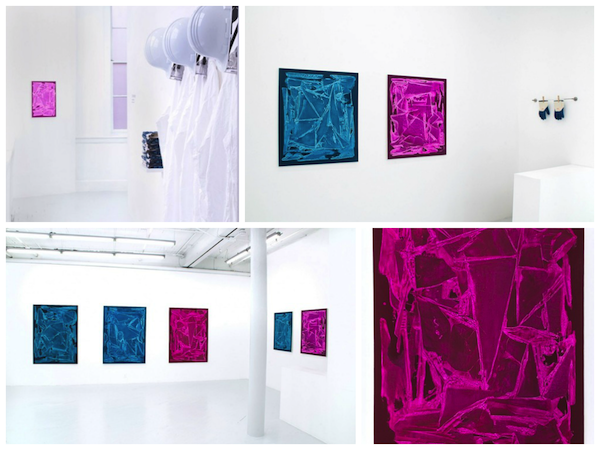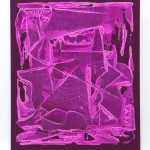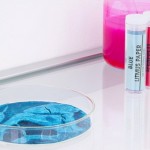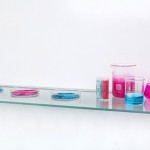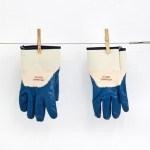If you’ve heard the name Seth Adelsberger in the past few years, it was most likely in reference to Nudashank, a locally-run warehouse gallery that exhibited a number of top emerging artists from Baltimore, NY, and across the country. Those who know him only through the gallery may not be aware that Adelsberger began his career as a painter after graduating from Towson University in 2002, and was soon after featured three times in New American Paintings, which led to exhibits all over the country. After many years of exhibiting, the artist chose to focus his creative energy on the gallery in 2009, which was co-founded and run with Alex Ebstein (a Bmoreart contributor). In the past four years, Nudashank’s exhibits and social media savvy have generated a high degree of visibility and branding for the young Baltimore art community within the larger art world.
Although the research and curatorial skills that go into running a gallery can greatly enhance an artist’s aesthetic and connections, if you are doing it well there’s no time left for the studio. This conflict between a professional project and a professional visual practice is not easily resolved and, for now at least, Adelsberger and Ebstein have closed the gallery to focus on their own creative endeavors.
Looking forward, Adelsberger will be exhibiting new works in a solo show at the Baltimore Museum of Art in June 2014. In the past few months, the artist has exhibited new works in “Grade (climbing)” at Makebish, NYC, “Regarding Territory” curated by Ginevra Shay at Furthermore, DC, and “Mechanical Turk” curated by FJORD Gallery at RISD. If his new solo exhibit, “Surface Treatment” at Springsteen Gallery in Baltimore, is any indication of what to expect from the artist-turned-gallerist-turned-artist, there is strong evidence of an intellectual depth and an understanding of material process that is growing exponentially.
According to press materials, “Surface Treatment” at Springsteen Gallery examines the chemical and scientific properties of painting.” In the series of works, titled The Submersion Paintings, the artist combines stains and washes over a gestural application of gesso. Working in batches where some individuals succeed and others fail, the goal of the new paintings is twofold. One one hand, the artist strives to achieve visual variations within magenta and turquoise palettes. The other goal is to reference synthetic pigments and printing processes (CMYK) and even the computer LED screens where most art is viewed today. When a Submersion painting succeeds, it has an inherent glowing effect, not unlike the backlit screens of phones and laptops.
Adelsberger’s new works also reference Color Field Painting and Abstract Expressionism, creating seemingly digital hybrids of the historically distinct movements. “The linear march of modernism only recognized clean breaks and categorical division between generations,” says Adelsberger in the “Surface Treatment” exhibition statement. “This left the work of transitional artists out of the historical dialogue. It is now possible and relevant to reexamine and further these neglected yet vital stylistic territories. Despite their gestural nature and deep coloring, the Submersion paintings are based more in a structured analysis and automatic approach than potential association with emotion and expression.”
After viewing the exhibition at Springsteen Gallery, Adelsberger agreed to answer my questions about the new work.
Cara Ober: Can we talk about the scientific, or pseudo-scientific objects in the gallery? I noticed white hazmat suits, white hats with goggles and different beakers and flasks with colored liquid in them. Because the colors of the additional items matched the colors of the paintings, it was visually seamless, but steered what could have been a straight-up painting conversation into something larger and possibly more vague. How do these additional items, besides the paintings, change the meaning of the work? In your opinion, what do painting and science have in common?
Seth Adelsberger: I made the paintings for Surface Treatment with the Springsteen space in mind. In following their programming and being familiar with the sterility and brightness of the space, I wanted to do a show that took full advantage of the conditions there. I like the idea of making “clinical” work. I wanted to (mis)direct the conversation to reflect and further play up the mystery of the process. The lab props, fluids, and safety gear introduce a “lens” that ideally directs the viewer’s experience with the work. Abstraction, after all, is more about suggestion than dictation. I like that the objects add specificity without providing any answers.
Painting is very much based on chemistry and I have found myself thinking more about paint on a micro level while working. For me, the hazmat suits refer to toxicity and are also a metaphor for separation and distancing.
CO: Although there were a number of different sized canvases, the paintings in this show came in two colors: Cyan and Magenta, which was highly intentional in referencing printing processes. What does industrial printing have to do with painting? What do these colors mean to you? And why no yellow?
SA: I started wanting to have a two-tone show, kind of like a polarity, but skewed in favor of the cools. In the case of the three large paintings, they create a particular tonal chord that, on a base level, is also a lopsided binary. I have steered away from yellow because it doesn’t have the deep saturation and dark value that contrasts with the gesso layer and creates luminosity. All the pigments are synthetic, and illustrate the chemistry implicit in paint. They are “base” colors and so I correlate them to the characteristics of RGB and CMYK.
CO: I am curious about the process behind these paintings and how you arrived at it. Two years ago you were deconstructing canvasses, building objects out of stretcher bars, and framing found images. Now you are creating abstract paintings which straddle the fence between minimal and expressive. Can you explain how you got here from there and possibly what happened in between?
These paintings build on abstract approaches and gestural templates from the work I was making in my undergrad years. My work was then, and still is, heavily academic and the result of synthesizing various historic styles and techniques.
“Surface Treatment,” alludes to the idea of painting as decorative procedure and the inevitable decorative trappings inherent in painting and abstraction. This same idea is behind the Border paintings I started making in 2010. They combine AbEx and Minimalism in a different way via Pollock and Stella. The allover field becomes a wrapped skin on a sculptural form; reduced to the shape of a frame. The Submersion paintings also use a border/framing device that is the result of feeling out the physical limits and proportions of each panel.
On the whole, I’m interested in continuing to develop a more conceptual approach that allows for shifting stylistic impulses. Regularly curating and installing shows at Nudashank for almost 5 years really changed how I think about assembling an exhibition. I now focus less on individual objects/images and more about how they fill a space and add up to something larger. This kind of relativity awareness creates more freedom.
CO: Can you talk about your new process? Why do you work with canvas mounted over wooden panels? How do you build up the surface? What kind of paint and tools do you use to create a range of painterly effects and also more mechanical ones?
SA: The process began developing in paintings on stretched canvases. It quickly made sense for the gestural movements to happen on a durable, rigid surface. Calling them Submersion paintings is partly deceptive. They aren’t actually submersed, however the paint and stain applications are very aqueous and require long periods of time to dry. I use thinned acrylics for the washes and staining and low-grade gesso for the “form.” The painting process happens with the support face up on a table and involves many washes of stain to create an even, saturated field. The “form” is the result of a single application of gesso. The gesso is pushed around with spackle knives and squeegees. The time window for this step is brief and decisions are made quickly. The dimensional gesso then requires about two days to fully cure.
A final wash of thinned acrylic is applied. This wash heightens the modulation, cracks, and bubbles in the gesso. I am often unsure and surprised by exactly what is revealed. In this way, the process does feel akin to developing a photo and watching the image emerge from the bath.
Mounting to panel maintains a level surface for the entire process, especially important as the paintings scale up. This flat surface prevents uneven pooling as the water evaporates from the pigment.
Seth Adelsberger: Surface Treatment will be on display at Springsteen Gallery through January 10, with a closing reception on Friday, January 10 from 6-8 pm.
Click on individual images below to enlarge and view.
* Author Cara Ober is the Editor at Bmoreart.




